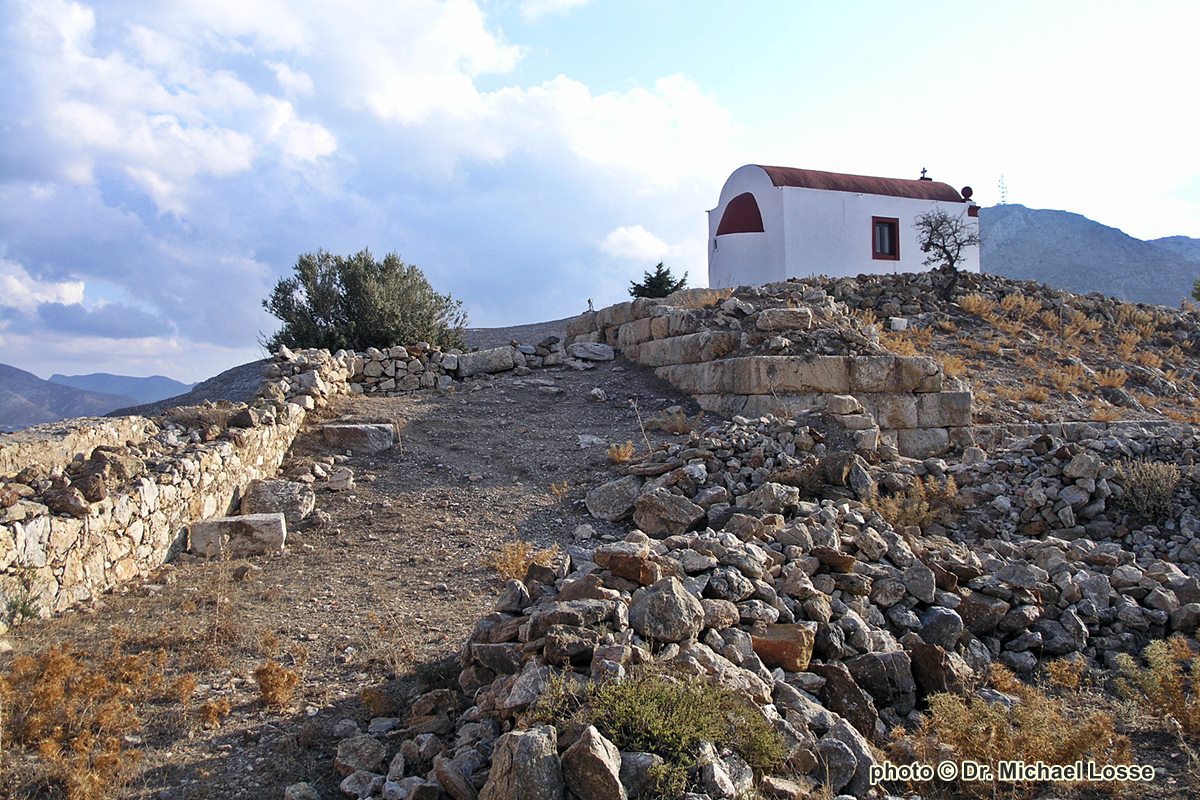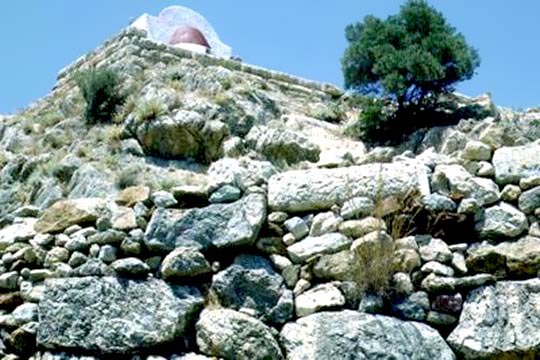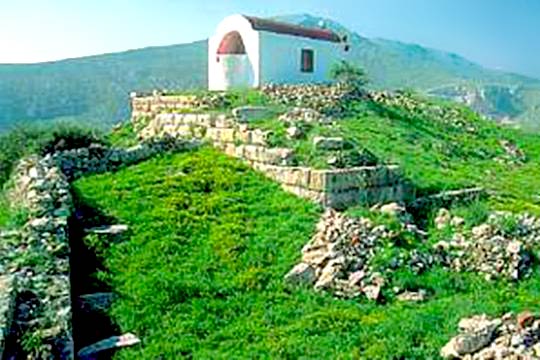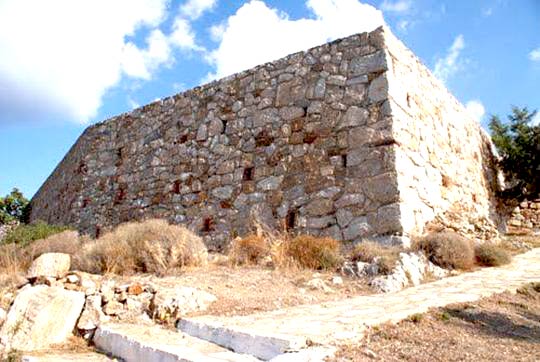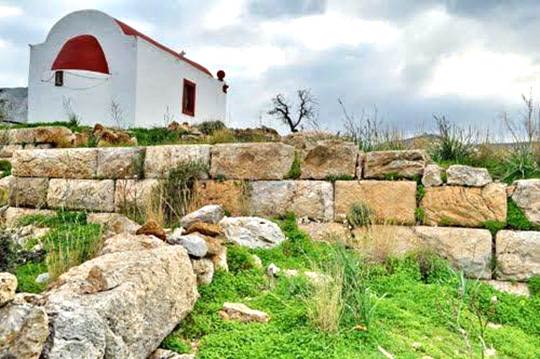Xirocampos, Leros, Dodecanese,South Aegean
Castle of Lepides
| Location: |
| Xirocampos, south part of Leros island |
| Region > Prefecture: | 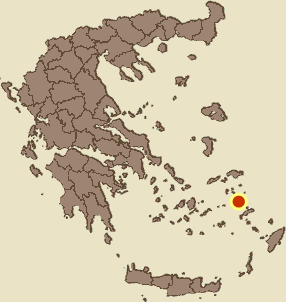 |
| South Aegean Dodecanese | |
| Municipality > Town: | |
| City of Leros • Xirocampos | |
| Altitude: | |
| Elevation ≈ 62 m |
| Time of Construction | Origin | |
| Various periods | BYZANTINE |
|
| Castle Type | Condition | |
| Castle Ruins |
Few Remains
|
Ancient fortification, converted into a medieval/Byzantine castle, later used as a graveyard.
Locally also known as “Kastro ton Lepidon” and “Palaio Ochyro”.
Castle Description
Text: Dr. Michael Losse – Singen (Hohentwiel), Germany (09.08.2021)General Description
In the south of the island, the large bay of Ormos Xerokampos opens up towards the island of Kalymnos, to which the plain of the same name with the settlement also called Xerokampos adjoins. The plain continues as a depression lined with mountain ranges on both sides to the large harbour bay of Lakki. On a hill at the end of the plain of Xerokampos, from the summit of which it is possible to see both of these bays, stands the Palaiókastro, which also offers visual connections to the Kástro tís Panjías near Plátanos, to Kastélli and to the large Vígla on Léros, to the Byzantine Kástro Galatianí on the island of Kálymnos and to the Byzantine Kástro (Ájios Konstntínos) on the island of Télendos.
The core of the Palaiókastro, which was later changed several times, is formed by an ancient (Hellenistic?) fort, of which walls have been preserved. The archaeologist Ludwig Ross (II 1843, p. 118) described his impression of the castle on "the narrow ridge", which seperates the port bay of Lepyra "from the bay of Xerokampos opening towards the northern tip of Kalymnos” as follows: “The goal of our ride, the so-called paleokastron, became apparent. It consists only of the ruins of a poorly walled monastery courtyard, on the ruins of a Hellenic watchtower with its ordinary courtyard of large rectangular hewn cuboids. Of the Tower, some stone layers above the ground are still preserved. Inside the walls there is now only a bad chapel, on the foundations of an older and much larger Byzantine church, of whose mosaic floor some remains are still preserved. That was all the glory of the paleokastron." (German original text: “das sogenannte Paläokastron […] besteht nur aus den Ruinen eines schlecht ummauerten Klosterhofes, auf den Trümmern eines hellenischen Wartthurmes mit seinem gewöhnlichen Burghofe aus großen rechtwinklicht behauenen Quadern. Von dem Thurme sind noch einige Steinschichten über dem Boden erhalten. Im Innern des Gemäuers liegt jetzt nur eine schlechte Kapelle, auf den Fundamenten einer ältern und weit größern byzantinischen Kirche, von deren Mosaikboden noch einige Reste erhalten sind. Das war die ganze Herrlichkeit des Paläokastrons.”)
The castle’s surviving medieval additions were pulled down in the 1950s.
Heslop (2014) characterized the castle as follows: “Built on Hellenistic foundations, the castle, standing at a height of only 62 m above the surrounding plain, can never have been very strong, and it is difficult to see there anything more than a simple rectangular fort with rough-hewn walls, a straightforward entrance and perhaps a tower. By the time that the Knights arrived, it was probably little more than a lookout position, though even then this function would have needed to be supplemented by additional watch-positions on the hills above the site.”
History of the castle
The core of the Palaiokastro, which was later changed several times, is formed by an ancient (Hellenistic, 4th century B.C.?) fort, of which walls have been preserved.
The fact that the castle was still in use in the Middle Ages is evidenced by the fact that after the transfer of the Kástro tís Panajías to Christodoulos in 1087/88, its previous inhabitants were forced to relocate to Palaiókastro (Loupou-Rokou 1999, p. 62). “According to a 1089 document, the castle was given to the inhabitants of Leros as a shelter since they had been excluded from using the castle of Panteli” (Heslop 2014).
It is obvious that the chivalric Order of the Knights of St. John also used the Palaiókastro, but their possible construction measures are no longer recognizable, since the fortification was re-fortified by the Italian occupying power in the context of the 2nd World War – remains of MG and gun positions as well as the sign house on the access road to the castle testify to this. Even in the 1990s, numerous cartridge casings and bullet splinters in the castle and all around testified to fighting in the 2nd World War.
A priest wanted to transform the Palaiókastro into a cemetery in the 1950s and therefore had it partially bullded and walls rebuilt (cf. Benson 1963).
Other Info
SourcesArmao, Ermano: Il giro per il Mar Egeo con Vicenzo Coronelli. Notedi Topologia, Toponomastica e Storia Medievali Dinasti e Famiglie Italiane in Levante. Con stemmi nel testo e un Atlante di 40 carte fuori testo. Florenz 1951, p. 164.
Benson, Jack L.: Ancient Leros (Greek, Roman and Byzantine Monographs, No. 3), Durham/North Carolina 1963.
Dawkins, R. M./Wace, Alan J. B.: Notes from the Sporades, Astypalaea, Telos, Nisyros, Leros. In: Annual of the British School at Athens, XII, 1905-06, pp. 151-174.
Δρελιώση-Ηρακλείδου, Α./Μιχαηλίδου,Μ.: Λέρος, Από την Προϊστορία έως τον Μεσαίωνα, Athens 2006.
Gerola, Giuseppe: I monumenti medioevali delle 13 Sporadi. In: Annuario Scuola Arch. Atene I, 1916, p. 66.
Heslop, Michael: The Search for the Defensive System of the Knights in the Dodecanese (Part II: Leros, Kalymnos, Kos and Bodrum). In: Mathias Piana/C. Carlsson (Eds.): Archeology and Architecture of the Military Orders. Ashgate 2014, pp. 29-67.
Hope Simpson, Richard/Lazenby, John F.: Notes from the Dodecanese II. In: Annual of the British School at Athens, vol. 65, 1970, p. 54.
Kollias, Ilias: Istorikes plerofories apo to archeio tes Mones Patmou gia te mesaionike Lero [Historical information from the archives of the Monastery of Patmos concerning Mediaeval Leros]. In: Ionias Akron - Leros. Tomos aphieromenos ste mneme tou Dion. Oikonomopoulou [The Tip of Ionia, Leros: Festschrift in memory of Dion. Oikonomopoulos] (Athens, 1993), pp. 73–97, here p. 85. [cited after Heslop 2014]
Losse, Michael: Die Kreuzritter von Rhodos - Bevor die Johanniter Malteser wurden. Ostfildern 2011.
Losse, Michael: Die Burgen und Festungen des Johanniter-Ritterordens auf Rhódos und in der Ägäis (Griechenland) 1307-1522. (Publisher: Nünnerich-Asmus Verlag) Mainz 2017.
Loupou-Rokou, Athena-Christina: The Aegean Fortresses and Castles. Athens 1999, p. 67.
Paradissis, Alexander: Fortresses and Castles of Greece. Vol. III: Fortresses and Castles of Greek Islands. Athens and Thessaloniki 1976, p. 148.
Ross, Ludwig: Reisen auf den griechischen Inseln Ägäischen Meeres. Zweiter Band. Enthaltend Andros, Syros, Mykonos, Amorgos, Astypaläa, Nisyros, Knidos, Kos, Kalymnos, Telendos, Leros, Patmos, Samos, Ikaros, DeIos, Rhenäa, Gyaros, Belbina. Stuttgart und Tübingen 1843, pp. 100-101.
Spiteri, Stephen C.: Fortresses of the Cross. Hospitaller Military Architecture (1136-1798). Valleta (Malta) 1994.
Spiteri, Stephen C.: Fortresses of the Knights. Ħamrun (Malta) 2001, p. 198.
Stefanidou, Alexandra: Castles of the Knights Hospitallers. In: Anna Triposkoufi/Amalia Tsitouri (Eds.): Venetians and Knights Hospitallers. Military Architecture Networks (ARCHI-MED Pilot Action) [Hellenic Ministry of Culture, Directorate of Byzantine & Postbyzantine Monuments]. Athens 2002, p. 184-253, here p. 253.
| First entry in Kastrologos: | March 2013 | Last update of info and text: | November 2021 | Last addition of photo/video: | November 2021 |
Sources
- Photo 1 (October 2007) and article by Dr. Michael Losse
|
|
| Access |
|---|
| Approach to the monument: |
| - |
| Entrance: |
| Free access |



